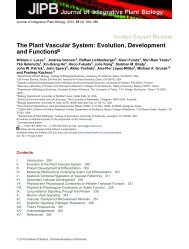Olmstead&Bohs.ActHor.. - Department of Biology - University of Utah
Olmstead&Bohs.ActHor.. - Department of Biology - University of Utah
Olmstead&Bohs.ActHor.. - Department of Biology - University of Utah
You also want an ePaper? Increase the reach of your titles
YUMPU automatically turns print PDFs into web optimized ePapers that Google loves.
Kulcheski et al., 2006); Iochrominae (Smith and Baum, 2006), Nolana (M. Dillon and J.<br />
Wen, pers. commun.), and, <strong>of</strong> course, Solanum (e.g., Spooner et al., 1993; <strong>Bohs</strong>, 2005;<br />
Levin et al., 2006; Weese and <strong>Bohs</strong>, 2007).<br />
RESULTS AND DISCUSSION<br />
In an effort to bring together the accomplishments <strong>of</strong> the past 25 years and to<br />
identify where our knowledge is most complete and where further work is needed, we<br />
have compiled a summary <strong>of</strong> molecular systematic studies in Solanaceae organized in<br />
conjunction with the classification in Table 1. In order to quantify the progress, estimates<br />
<strong>of</strong> the number <strong>of</strong> species in each group were revised from prior compendia (D’Arcy,<br />
1991; Hunziker, 2001) where needed using recent publications and the assistance <strong>of</strong><br />
authorities in those groups. A new estimate <strong>of</strong> species number in Solanum was calculated<br />
from estimates <strong>of</strong> the ratio <strong>of</strong> accepted species names to published species names in<br />
recently monographed groups and extrapolated to the rest <strong>of</strong> the genus (S. Knapp and J.<br />
Bennett, pers. commun.). Table 1 provides estimated numbers and percentages <strong>of</strong> species<br />
sampled for each genus and <strong>of</strong> genera sampled for suprageneric clades compiled from all<br />
studies. Studies are referenced to each genus or clade for information on phylogeny<br />
within that group or on the placement or the genus or clade within the Solanaceae. Clade<br />
names in Figure 1 follow Olmstead et al. (1999) with the exceptions <strong>of</strong> “Salpichroina,”<br />
“Lyciina,” and “Atropina,” which are unranked informal names used here for the first<br />
time. The “-ina” ending does not denote a formal taxonomic rank, but is used in<br />
accordance with other studies coining informal clade names (Kron, 1997).<br />
Sampling at the genus level is nearly complete (94%), with only a few hard-to-get<br />
taxa remaining to be sampled. However, sampling is uneven at the species level with a<br />
total <strong>of</strong> ca. 37% sampled. Some large clades, including Cestrum, Brunfelsia, Lycianthes,<br />
Jaltomata, and Juanulloeae remain poorly sampled. Solanum, with nearly half the species<br />
in the family, is somewhat undersampled at the moment with ca. 31% <strong>of</strong> species sampled,<br />
vs. 37% for the entire Solanaceae (Fig. 2, Table 1). However, there is a major effort<br />
underway to understand the global taxonomy and phylogeny <strong>of</strong> Solanum (Knapp et al.,<br />
2004; Solanaceae Source: http://www.nhm.ac.uk/solanaceaesource/) and a molecular<br />
phylogeny <strong>of</strong> Solanum is progressing at a rapid rate (<strong>Bohs</strong>, 2004, 2005; Levin et al.,<br />
2005, 2006; Martine et al., 2006; Weese and <strong>Bohs</strong>, 2007; <strong>Bohs</strong>, in press; L. <strong>Bohs</strong> and D.<br />
Spooner, pers. commun.).<br />
A primary goal <strong>of</strong> systematics is to discover and describe biodiversity at all levels<br />
in the hierarchy <strong>of</strong> life. Discovery occurs in the field, the herbarium, and in the lab, where<br />
molecular phylogenetic studies enable the discovery <strong>of</strong> clades thoughout that hierarchy.<br />
Having a fully sampled and fully resolved phylogeny for Solanaceae will permit<br />
interpretation <strong>of</strong> patterns <strong>of</strong> character evolution, biogeography, and genome structure<br />
resulting in a fully integrated biology <strong>of</strong> the Solanaceae.<br />
Acknowledgements<br />
We thank several scientists who graciously provided summaries <strong>of</strong> their<br />
unpublished research and estimates <strong>of</strong> species numbers for groups on which they work,<br />
including T. Barkman, J. Bennett, M. Dillon, S. Knapp, R. Levin, M. Manoko, T. Mione,
















